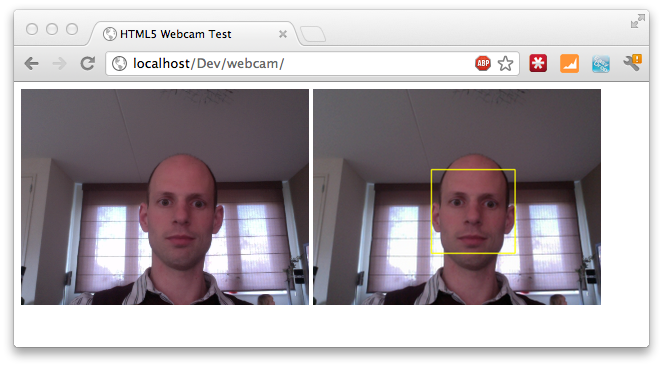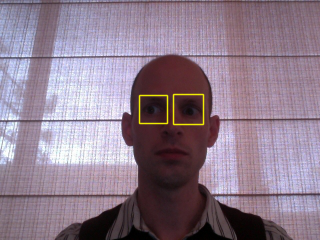这是一篇国外的文章,介绍如何通过 WebRTC、OpenCV 和 WebSocket 技术实现在 Web 浏览器上的人脸识别,架构在 Jetty 之上。
实现的效果包括:
还能识别眼睛
人脸识别的核心代码:
页面:
1 2 3 4 5 6 7 8 9 10 11 12 13 14 15 16 17 18 19 20 21 22 23 24 | <div> <video id="live" width="320" height="240" autoplay style="display: inline;"></video> <canvas width="320" id="canvas" height="240" style="display: inline;"></canvas></div> <script type="text/javascript"> var video = $("#live").get()[0]; var canvas = $("#canvas"); var ctx = canvas.get()[0].getContext('2d'); navigator.webkitGetUserMedia("video", function(stream) { video.src = webkitURL.createObjectURL(stream); }, function(err) { console.log("Unable to get video stream!") } ) timer = setInterval( function () { ctx.drawImage(video, 0, 0, 320, 240); }, 250);</script> |
后台:
1 2 3 4 5 6 7 8 9 10 11 12 13 14 15 16 17 18 19 20 21 22 23 24 25 26 27 28 29 30 31 32 33 34 35 36 37 38 39 40 41 42 43 | public class FaceDetection { private static final String CASCADE_FILE = "resources/haarcascade_frontalface_alt.xml"; private int minsize = 20; private int group = 0; private double scale = 1.1; /** * Based on FaceDetection example from JavaCV. */ public byte[] convert(byte[] imageData) throws IOException { // create image from supplied bytearray IplImage originalImage = cvDecodeImage(cvMat(1, imageData.length,CV_8UC1, new BytePointer(imageData))); // Convert to grayscale for recognition IplImage grayImage = IplImage.create(originalImage.width(), originalImage.height(), IPL_DEPTH_8U, 1); cvCvtColor(originalImage, grayImage, CV_BGR2GRAY); // storage is needed to store information during detection CvMemStorage storage = CvMemStorage.create(); // Configuration to use in analysis CvHaarClassifierCascade cascade = new CvHaarClassifierCascade(cvLoad(CASCADE_FILE)); // We detect the faces. CvSeq faces = cvHaarDetectObjects(grayImage, cascade, storage, scale, group, minsize); // We iterate over the discovered faces and draw yellow rectangles around them. for (int i = 0; i < faces.total(); i++) { CvRect r = new CvRect(cvGetSeqElem(faces, i)); cvRectangle(originalImage, cvPoint(r.x(), r.y()), cvPoint(r.x() + r.width(), r.y() + r.height()), CvScalar.YELLOW, 1, CV_AA, 0); } // convert the resulting image back to an array ByteArrayOutputStream bout = new ByteArrayOutputStream(); BufferedImage imgb = originalImage.getBufferedImage(); ImageIO.write(imgb, "png", bout); return bout.toByteArray(); }} |
详细的实现细节请阅读英文原文:

